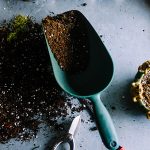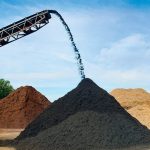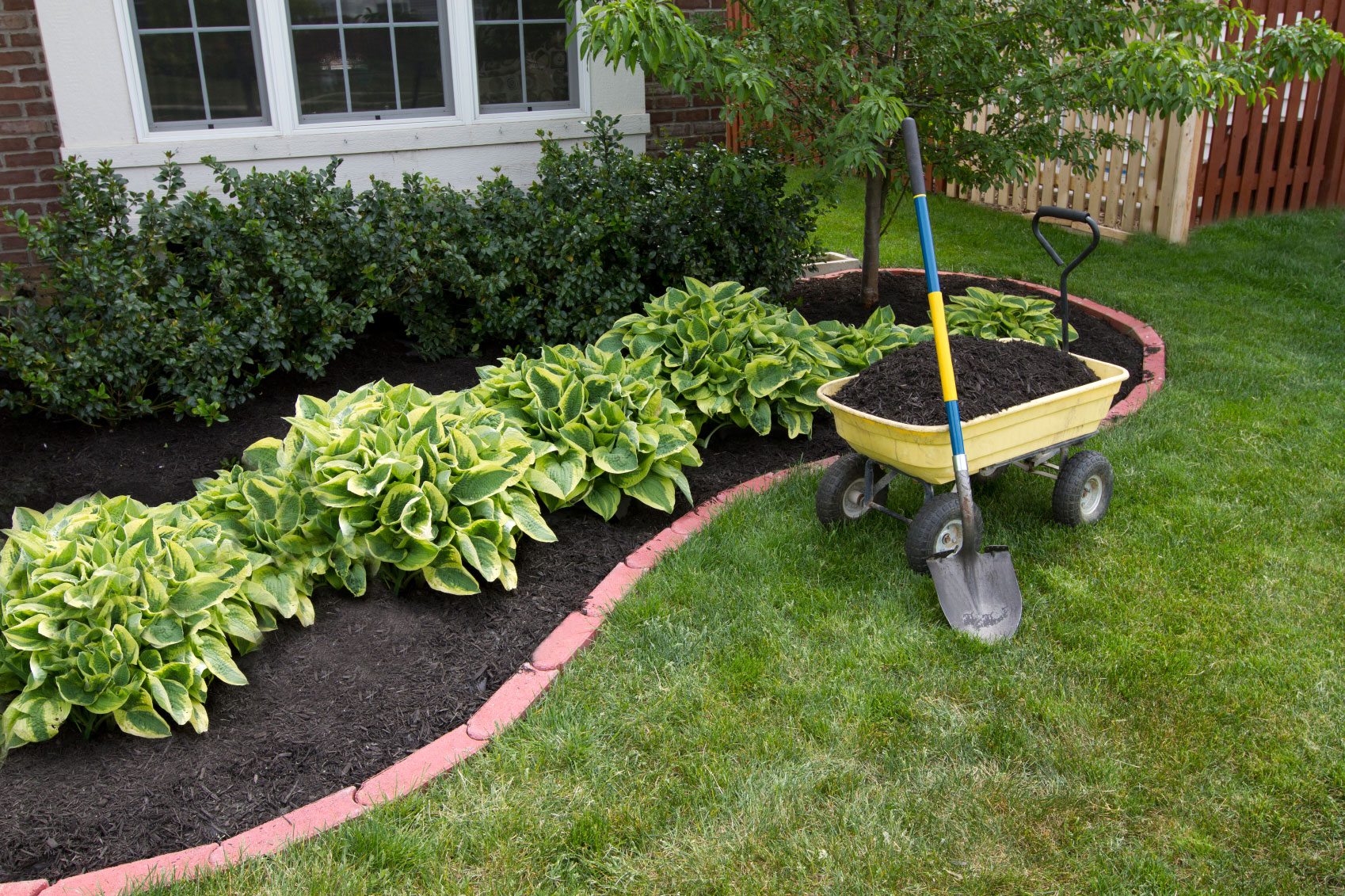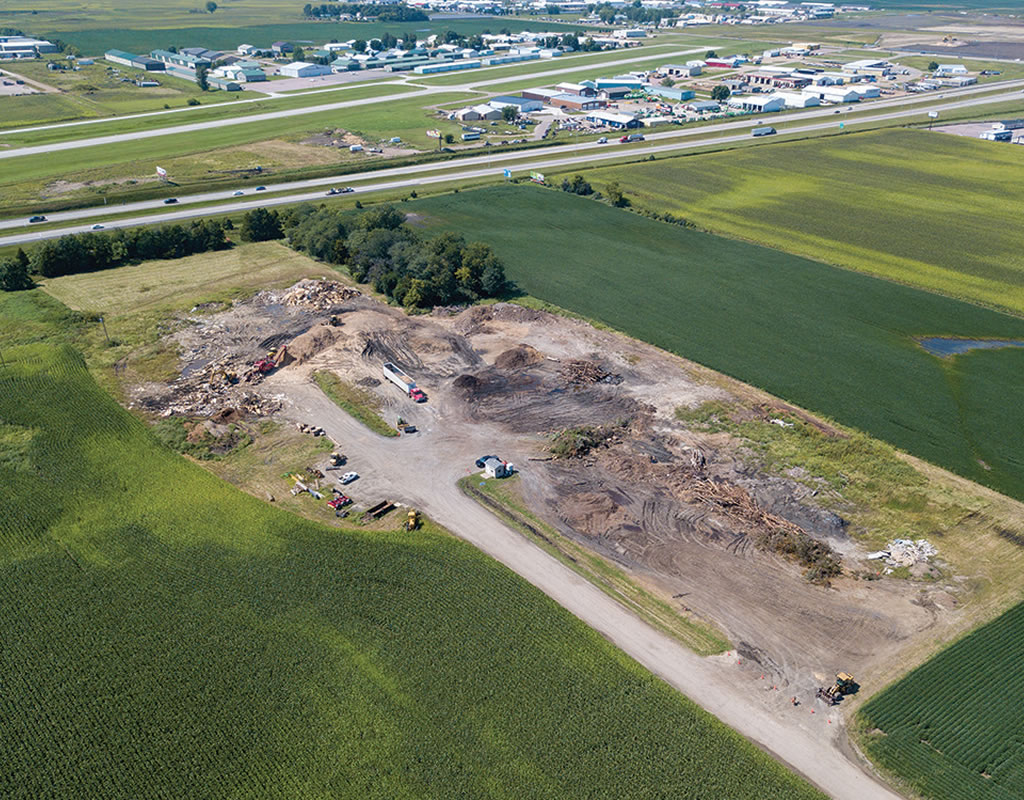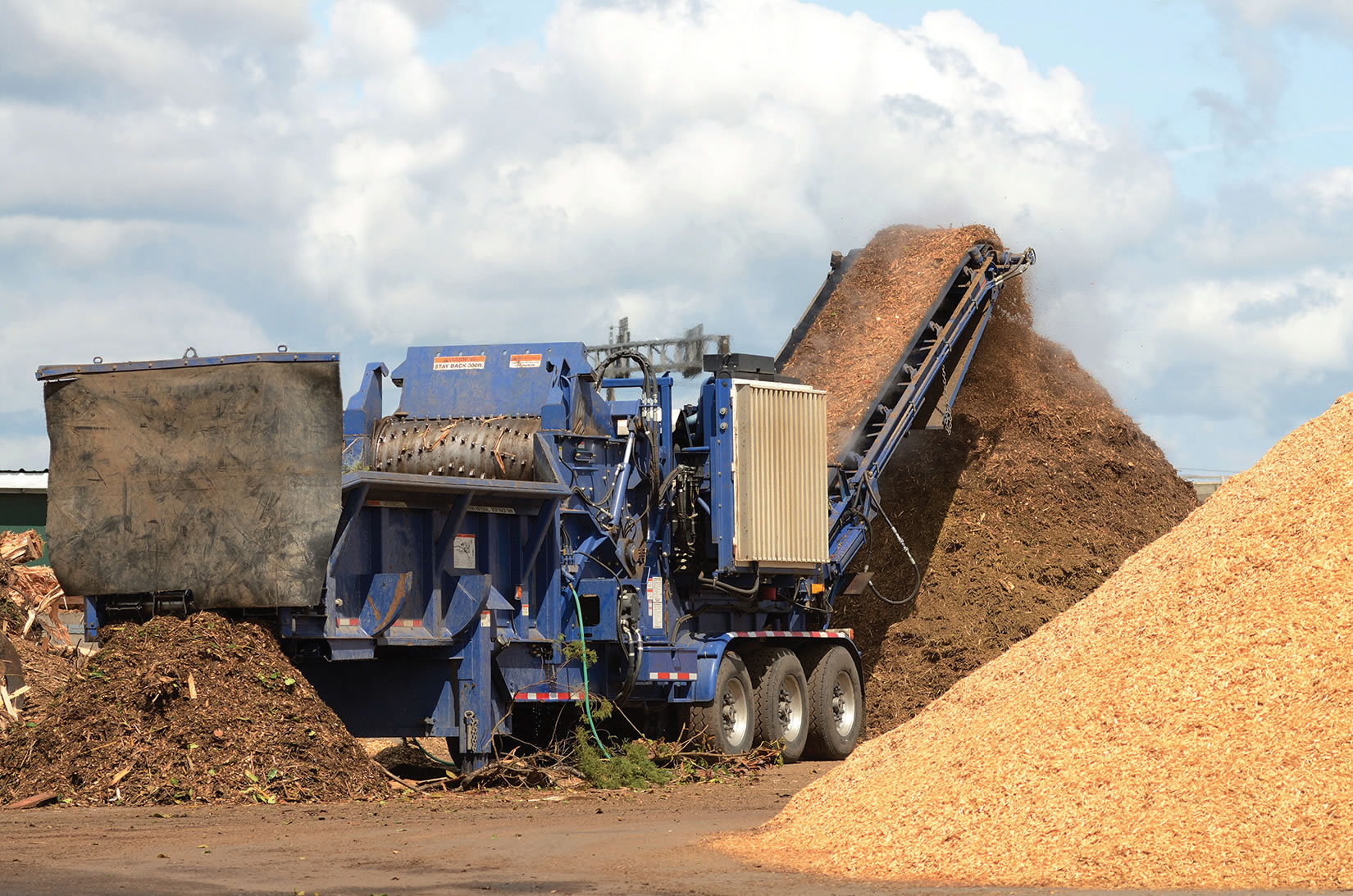By P.J. HELLER
Matt Smith wonders what he would be doing today if his company wasn’t selling colored mulch.
“I’d probably not still be in the mulch business,” says Smith, chief executive officer of Smith Creek, Inc., in Borden, IN.
Smith Creek got into the wholesale colored mulch business in the late 1990s and today its bagged colored mulch outsells natural mulch by as much as 95 percent. Bulk sales of colored mulch are 85 percent higher than natural mulch, Smith reports.
Other mulch manufacturers report similar success selling colored mulches, particularly browns, reds and blacks.
Fortunately for mulch producers, there is a wide variety of options to chose from when selecting a colorant system. Those options include stand-alone coloring systems some of which are transportable, horizontal grinders with optional or dedicated coloring systems, and injection pump systems that can be adapted to an existing grinder or trommel system. Sophisticated electronics on some units help minimize water and colorant usage.
Many colorant equipment manufacturers, as well as other companies, offer a wide range of colorants in liquid or powder/granular form; with liquid-based colorants being the most commonly used.
“In its simplest form, it’s like baking a cake,” says one longtime industry expert when discussing colorizing mulch. “You’re just mixing contents and stirring it around so colorant is absorbed into the material. There’s a wide variety of delivery systems and it just depends on how sophisticated you want to be. It also depends on your volume and economics…” Understanding those delivery systems — and the actual costs and benefits associated with each — is crucial.
“I would say the most critical thing mulch producers can do is to contact an industry expert and let them sit down and talk them through the process,” advises a spokesman for a leading colorant equipment company.
That process includes discussing the various types of colorant systems, the market being served, production capabilities, how many colors to be produced, the wood source and the actual cost of each type of system.
For example, adding a colorant pump and a spray bar to inject the color to an existing grinder may be a cost-effective solution for some mulch producers, especially those who want to test the market or who have excess capacity on their grinder. However, some of those cost savings may be offset by higher colorant and water usage compared to a stand-alone system. The greater moisture content in bagged products, for instance, could result in higher freight costs. Also essential is to have an operator closely monitoring the equipment to avoid over application of colorant if the production rate should drop due to equipment wear.
Manufacturers of stand-alone colorant systems say their equipment offers more control, accuracy and consistent application to produce a superior product.
Adding a pump injection system with spray bar to an existing grinder or trommel is the least expensive option from a hardware standpoint, running about $10,000.
That was the option that Scott Ledford decided to take when he decided to get into the mulch business about six months ago.
“I think it’s the most efficient way for my operation,” says Ledford, who launched his Metrosite Forestry Products in an effort to divert C&D waste, waste pallets and other such materials from the landfill and to find a viable use for them.
Ledford plans to add a horizontal grinder to his Georgia operation as a backup to the trommel.
Adding a new horizontal grinder can run from $500,000 and up. A stand-alone coloring system can cost anywhere from $125,000 to $250,000. Used equipment is available and may provide a lower cost option for a mulch producer wanting to get into the market.
Colorant can be added to both wood products (i.e. wood pallets and C&D materials), as well as mixed green waste; the latter of which has become the predominant source of material used in today’s colored mulch.
Some of the manufacturers that offer colorizing systems and/or pumps include:
— AgriCoatings, a division of American Colors, Inc., markets both the Renegade and Orion systems which can convert existing equipment into an accurate colorizer, maximizing efficiency and reducing costs due to colorant waste. The Renegade offers variable throughput from 40 to 800 yards per hour.
— Amerimulch, offering the ColorTrom300 with its integrated Marksman technology to constantly measure the production rate and calculate the desired water and colorant application rates. Amerimulch, a business division of ChromaScape, also markets the MobileTrom, a self-contained, transportable unit.
— Bandit Industries, with its Beast horizontal grinders and optional Color Max colorizer system, which is designed to use less water and colorant to create rich, evenly colored mulch.
— BASF, featuring the Sahara X3 and Sahara Pro stand-alone coloring systems, both with a Global Equipment Management electronic control system that can provide a suite of reporting capabilities.
— Diamond Z, offering its liquid injection system, which sprays liquid colorant directly into the rotating valve of its grinders.
— Florida Coastal Color, which markets the V-Max 300 color unit and the CP-250 and CP-500 portable pump units that can convert any grinder or trommel into a coloring system.
— Greenwood Farms, offering the Color Critter G3 dry color dispenser as well as the Color Drum, a liquid color dispensing unit that fits any trommel-style screener.
— Mulch Manufacturing, which sells the heavy-duty Cheetah coloring system and the smaller Cheetah Cub, which can be moved or be operated as a portable unit. The company also is a mulch producer.
— Rotochopper, offering its patented grind and color system that features the company’s “perfect in one pass” technology.
— T.H. Glennon Co., with its compact and economical Mulch Color Jet coloring unit that can be added to existing mulch processing equipment.
— Timber Ridge Equipment manufactures a self-contained mulch coloring system called the Chameleon, as well as individual coloring pumps that can be integrated with a grinder or trammel screen.
Justifying the cost for colorant can be easily made, with colored mulch typically selling for more than natural mulch, notes one industry expert.
“The cost for you to add colorant to mulch — whether it’s bagged or not bagged — is less than the diesel fuel used to deal with the mulch,” he says. “It’s less than the manpower. It’s less than the plastic bag that the mulch goes into. There are multiple areas that cost more than the colorant when it comes to coloring mulch.”
Adam Martin, owner of Martin’s Farm and Compost, says offering colored mulch has been a boon to his business. About two-thirds of the bulk mulch sold at his Greenfield, MA, facility is colorized, with the other one-third natural mulch, he reports.
“It’s improved my business,” Martin says of offering colored mulch since 2011. “It makes me more versatile with being a ‘one- stop shop.’ I get people coming in for compost and they see the colored mulch, and vice versa.” Steve Condos of Metker-Ech, Inc., in Hartville, Ohio, echoes those sentiments.
“It (colored mulch) has increased our sales overall,” Condos says.
For those readers who may have an interest in purchasing a mulch colorizing system, here is some additional information on each of the manufacturers mentioned in this article:
AgriCoatings
AgriCoatings offers the Renegade, a portable, accurate colorant pump injection system, and the Orion, its most advanced system, to transform a grinder, trommel, new or used coloring machine into an accurate colorizer. The Renegade features a 2-inch quick-connect manifold that utilizes a gate valve to control water flow that is read with a non-clogging water meter. The Renegade can be upgraded with a Human Machine Interface (HMI) unit that allows for more functions, such as automated control through an app on a smart device or the tracking of production data. The Orion uses a laser that scans mulch throughput. This information is communicated to the PLC which in turn regulates color pump speed and water flow based on parameters initially set by the user. This autonomous control allows for production of a more consistently colored product. The Orion and Renegade/HMI systems provide a way to collect accurate production data and colorant consumption information.
AgriCoatings - 909 Tennessee Blvd. Lebanon, TN 37087 www.agricoatings.com
Amerimulch
The ColorTrom 300 is described as a no-wear, low-maintenance system that can produce up to 350 color-enriched cubic yards of mulch per hour. Introduced in 2016, the system utilizes a newly designed colorant and water-spray delivery system that reduces water, colorant and energy. The ColorTrom 300 features a twin drive assembly without chains and gears resulting in lower maintenance. There are also no paddles or liners to replace, so uptime is maximized. A twin spray-bar assembly distributes water and colorant in two sections to reduce water application rates and provides a more concentrated application of colorants. The Marksman system integrates with the ColorTrom 300 to only activate the colorant pump when fiber is present to eliminate colorant waste in an empty drum. The ColorTrom 300 includes a bulk feed, low-profile hopper that holds up to 20 cubic yards. Amerimulch also offers the MobileTrom, a self-contained, transportable unit that can produce up to 120 cubic yards per hour.
Amerimulch - 2055 Enterprise Parkway Twinsburg, OH 44087 www.amerimulch.com
Bandit Industries
Bandit Industries offers the Color Max coloring system built into The Beast horizontal grinders. The Color Max sprays directly to The Beast’s patented cuttermill, which thoroughly and evenly coats material during processing. The Color Max system is a Florida Coastal ERCP350 coloring system with a 1/3 horsepower, 220v three-phase electric variable speed weather resistant motor and pump. Its external controller will typically sit near The Beast. A water source is run to the controller, and another line is hooked into the colorant. Operators can easily dial in the correct amount of color to pump based on the flow of water and the quality of the colored mulch. It can be run by one person. Everything is accessible via remote controls. From a loader feeding The Beast, the operator can control all the functions of The Beast, start and stop the flow of color to the mill, and monitor the color quality.
Bandit Industries, Inc. - 6750 Millbrook Road Remus, MI 49340 www.banditchippers.com
BASF
On offer from BASF is the Sahara X3 and the Sahara Pro mulch coloring systems, both designed to use the minimal amount of water and colorant needed to produce colored mulch. The X3, with its 100hp motor, can produce up to 300 cubic yards per hour; the Pro, with its 75hp motor, can produce up to 350 cubic yards per hour. In most cases, the entire system can be run by a single operator, reducing labor costs. Costs are also saved by the precise use of water (20 to 70 gallons per minute for the X3 and 8 to 70 gpm for the Pro) which also minimizes drying time. The Global Equipment Management system for both units allows for operators to store, retrieve and use with a touch of the screen. It also provides reporting capabilities including number of hours and time of day the machine is used, total output, and colorant and water use.
BASF - 1725 Dayton Ave. Ames, IA 50010 www.colorbiotics.basf.us/en
Diamond Z
Diamond Z introduced their liquid injection system back in 1989. Since then Diamond Z has used this method of spraying water directly into the rotating mill as a method of evenly dispersing water, colorants and other products for many purposes. All Diamond Z mills can be equipped with a water injection system that injects water or other liquids evenly and directly in to the grinding chamber. By directly injecting the liquid into the grinding chamber, the processed material will become evenly coated by a multi-port manifold behind the deflector plate (tub models) or the mill hood (horizontal models).
Diamond Z - 11299 Bass Lane. Caldwell, Idaho 83605 www.diamondz.com
Florida Coastal Colors
The V-Max 300 from Florida Coastal Colors is one of three machines to colorize mulch. The V-Max 300 is a stand-alone color unit with the ability of producing 300-plus cubic yards per hour. It uses a 100hp motor and has an extra long 24-foot mixing chamber which allows full coverage with minimal water usage. It uses abrasion resistant steel for the mixing tub and paddles, which the company says provides extra long life to parts that normally have short life spans. The CP-250 and CP-500 units are portable pump machines that can turn any grinder or trommel into a coloring system. They are remote controlled; controls can start and stop both the colorant and the water supply. The units can be customized and are capable of producing 25 to 1,000 cubic yards per hour of colored mulch. A variety of options are available, including a low material whisker, 12-, 24- and 36-volt DC inverters, and a dual pump.
Florida Coastal Colors - 550 Elm St. / PO Box 778 Helena, AL 35080 www. floridacoastalcolors.com
Greenwood Farms
Greenwood Farms offers the Color Drum, a liquid color dispensing unit that fits any trommel-style screener, and the Color Critter G3, which the company touts as the only dry color dispenser on the market. The Color Critter granular color dispenser features simplified electronics, a large capacity hopper to accommodate standard industry colorant packaging, low water usage in the field and adaptability to any standard size grinder (it also can be modified for other equipment). It can disperse colorant accurately from 75 to 300 yards of re-grind per hour depending on the recyclers horsepower and screen set-up. It combines a dry granular coloring pigment with a precise, electronically controlled metering system that operates off the recycler’s electronic controls. The quantity of colorant being discharged can be adjusted by turning the colorant control knob on the control panel. The Color Drum for liquid color dispensing can produce 100 to 300 yards per hour, depending on trommel size.
Greenwood Farms 4278 Albany St. Albany, NY 12205 www.colorcritter.com
Mulch Manufacturing/Nature’s Reflections
Mulch Manufacturing offers the Cheetah family of coloring machines through its Nature’s Reflections division. The high-capacity Cheetah Coloring System can color up to 300 cubic yards of mulch per hour, while the smaller Cheetah Cub can produce up to 80 to 100 cubic yards per hour. An optional set of wheels can be added to the Cub allowing it to be moved or operate as a portable. Both rotating trommel systems operate on a 480v/3ph electrical system, which the company says is one of the most cost-effective to operate and use today. New technology in the Cheetah system allows it to use less water and horsepower (i.e. 25 hp for the Cheetah versus 45hp to 70hp for typical auger and paddle style coloring machines, which the company says results in a sizeable energy savings over a production season). The Cub uses 10 horsepower motors. Both machines use only 7 to 8 gallons of water per cubic yard of mulch.
Mulch Manufacturing, Inc. 6747 Taylor Road SW Reynoldsburg, OH 43068 www.mulchmfg.com
Nature’s Reflection - 108 Wilhelm Drive Monaca, PA 15061 - www.natures-reflections.net
Rotochopper
R0tochopper launched its patented grind and color system in 1997, allowing customers to simultaneously grind and color their wood waste into colored landscape mulch. The system injects water and colorant directly into the grinding chamber, using the force of the grinding process to thoroughly mix colorant into the wood fiber. The entire process is completely self-regulated and easy to adjust to match wood fiber consistency and mulch specifications. The colorant injection turns on automatically when raw material enters the grinding chamber and turns off when the grinding chamber runs empty, minimizing colorant usage and mess. The grind and color system is designed to lower handling costs and reduce colorant usage and spillage while producing colored mulch at the lowest cost per yard. Rotochopper has introduced its 2nd generation colorizer, offering what it calls its “perfect in one pass” technology. Rotochopper equipment is available in a wide horsepower range to match feedstock and product requirements.
Rotochopper, Inc. - 217 West St. / PO Box 295 St. Martin, MN 56376
T.H. Glennon
The Mulch Color Jet from T.H. Glennon is a compact coloring unit that adapts to tub, horizontal, trommel screens and stationary mills and auger conveyors. It can also add colorizing capability to existing mulch processing equipment. Once in place, it is ready to efficiently pump color into the grinder, during the grinding process. The Color Jet, first introduced in 1999, is available in three models: AC powered, AC powered with optional remote, and 24-volt DC. Each features a standard 1/3hp electrical motor, an electronic keypad for variable colorant output and a Signet water flow meter. Depending on the model, the Color Jet can produce from 225 to 450 cubic yards per hour. The Color Jet is designed to reduce wood handling time, equipment costs, fuel/energy as well as maintenance and repair expenses. The company says the system can save users approximately $2 per yard on colored mulch production, adding thousands of dollars to their bottom line.
T.H. Glennon, Co. - 25 Fanaras Drive Salisbury, MA 01952 www.MulchColorJet.com
Timber Ridge Equipment
The “Chameleon” is a self-contained coloring machine, with optional hydraulic-fold hopper-sides available. It is remote-controlled, with specifically designed screens, a four wheel drum and is completely portable. The largest machine is said to produce more than 400 yards of colored mulch per hour. Timber Ridge also manufactures a mulch coloring pump, available in three different sizes, that can pump between .15 to 6.8 gallons per minute. Each pump can be integrated with your current system or with the Chameleon Colorant System.
Timber Ridge Equipment - 55 Woodcrest Drive Ephrata, PA 17522 cmcmulchcolorants.com/equipment
Related News
Subscribe Today
Every other month, Soil & Mulch Producer
News brings you important stories about:
• New Technology
• Products
• Industry News
• Research Studies
Soil & Mulch Producer News features articles and services relevant to your daily operations.


